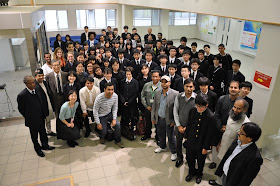Today we went on a trip with Takeuchi-sensei along the Northern part of the Sakura river. We saw Tsukuba mountain's Hojo ooike (big pond), visited the Amabikikannon and fed the peacocks, and went to the origin of the Sakura river as well as the Isobe Inamura jinja, which is the origin of Noh theater in this region and guards different Sakura tree species.
Hojo is a town in the North of the Tsukuba municipality, just South of its own little mountain. The Sakura river has not had many floods, but in 1986 the vicinity was affected. Hojo harbors these lakes mainly for fishing and irrigation rather than flood prevention, but it still helps. A little more upstream we encountered the same bridge we crossed when cycling to mount Tsukuba, and the inflatable dam. As opposed to the Netherlands, this dam is deflated during the flood season, and inflated to aid in, again, irrigation of the rice paddies. I was not so confident as professor Takeuchi, especially after noticing the air coming out of the dam suspiciously close to the drop point of the fishermen's hooks...







Our next stop was the Amabikikannon temple. Although the main theme of blessings here may be children and pregnancies, the name refers to pulling the water out of the sky (once more, for the harvest). The final temple, Sakuragawa Isobe Inamura Jinja, is said to be the origin of Noh theater in this region and is actually built around a stage where No was performed. It was possible to get a cleansing blessing while No theater music was playing. There is a total of 11 different sakura trees protected at this shrine, making it the best place for hanami. The differences between the trees can be very subtle or plain to see: different bark or petal colors or shapes, the amount of petals, fading color towards the end of the petals, one stamen transformed into a petal shape... it was definitely worthwhile to see all these differences. Here, we were fortunate enough to meet an employee of Sakuragawa city. He enthusiastically explained all our questions on floods in the Sakura river. He was even kind enough to guide us to the origin of the Sakura river. Nearby the shrine were an old Tsubaki tree and a holy pond, the poor water quality clarifying the issue of the untouchability of holy grounds.

















